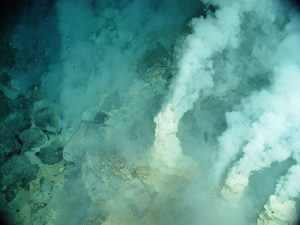There are amazing and unique habitats in the deep sea: the abyssal plains, hydrothermal vents and cold seeps, seamounts (underwater mountains) and the deep-water column. These all have distinct types of life.
Hydrothermal vents
A 60,000 km-long, underwater mountain range stretches around the planet, formed as the plates that make up the Earth’s crust move against, or apart from, each other. In these areas, seawater seeps into cracks in the seafloor, heating as it meets molten rock beneath the crust and then rising again to gush out of seafloor openings. These are hydrothermal vents. The water that emerges can be 400 degrees centigrade and extremely rich in minerals.
These vents were only discovered in 1977 and the ecosystems associated with them are unique on the planet. Their webs of life are based around microbes which use chemicals from the vents to produce energy. This process, chemosynthesis, is comple

tely different from the photosynthesis which is the foundation of most life on Earth.
Some of these heat-resistant bacteria live symbiotically with organisms such as tubeworms and mussels. Others are free-living and may be found growing on rocks, tubeworm tubes and other animals – even inside the vent chimneys. Other specialized and unique species living near hydrothermal vents include crabs, squat lobsters, limpets, alvinella worms, scaleworms, zoarcid fish, and octopus.
The “Lost City” field of hydrothermal vents in the middle of the Atlantic Ocean, only discovered in 2000, features hundreds of white spires between 30 and 200 feet tall – each one spewing hot alkaline fluid and supporting trillions of uniquely adapted microbes. It is now part of a mining exploration contract issued by the International Seabed Authority.
Abyssal plains
Abyssal plains are some of the flattest places on earth, covering about half of the deep ocean floor. They form a storage area for Earth’s carbon which should not be disturbed.
Their flatness is the result of thick blankets of sediment – sometimes five kilometers thick – accumulating over millennia. Abyssal hills can occur where the sediment is not thick enough to cover the underlying rock. These hills are usually extinct volcanoes or formations caused by molten lava.
The abyssal plains include some of the deepest areas of the ocean and remain in perpetual darkness. Yet they are also home to many species including the deepest-dwelling octopus.
Seamounts
Seamounts are underwater mountains that rise 1,000 meters or more from the seabed without breaking the ocean’s surface. They are home to cold-water coral reefs and forests, sponge beds and hydrothermal vents and support a huge variety of life in the deep.
Seamounts accumulate enormous quantities of plankton, which in turn attract a vast array of marine life. They provide food as well as spawning grounds for thousands of species, some stopping off after long ocean migrations. Seamounts are like an oasis in the desert, home to large marine mammals such as dolphins and whales, and an extraordinary diversity of fish, exotic sponges and corals.
And because many are located in remote surroundings – effectively underwater islands – studies are continually finding previously unknown species. Seamounts are amongst the world’s greatest biological treasures.
